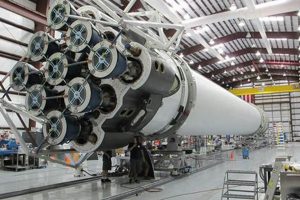Aeronautical engineering focuses primarily on the design, construction, and study of aircraft that operate within Earth’s atmosphere. This field encompasses aerodynamics, propulsion systems, aircraft structures, and control systems relevant to flight within the atmosphere. Examples of aeronautical engineering applications include the design of commercial airliners, fighter jets, and helicopters, optimizing their performance and efficiency for atmospheric flight.
Aerospace engineering, on the other hand, is a broader discipline that extends beyond Earth’s atmosphere to include spacecraft, satellites, and rockets. It encompasses the principles of aeronautical engineering but also incorporates aspects of astronautics, such as orbital mechanics, space environment, and life support systems. This field plays a vital role in space exploration, satellite communication, and the development of technologies for space travel. The evolution of both disciplines is deeply intertwined with advancements in materials science, propulsion technologies, and computational modeling, each contributing significantly to technological progress.
The core distinction lies in the operational environment: one is restricted to atmospheric flight, while the other extends to the vacuum of space. Consequently, curricula for these engineering branches differ, with aerospace engineering typically including specialized courses in orbital mechanics, spacecraft design, and related topics. The practical application and career paths also vary, reflecting the specialized skills needed for each domain.
Distinguishing Between Aerospace and Aeronautical Engineering
Understanding the nuanced differences between these two engineering disciplines is crucial for students, professionals, and anyone seeking clarity in this field. Careful consideration of the following points can provide a more comprehensive understanding.
Tip 1: Define the Operational Environment: Aeronautical engineering is inherently tied to Earth’s atmosphere. Aerospace engineering expands this domain to include the vacuum of space. Understanding this foundational difference is paramount.
Tip 2: Examine Coursework and Specialization: Aeronautical engineering curricula focus on aerodynamics, aircraft structures, and propulsion systems optimized for atmospheric flight. Aerospace engineering incorporates these elements but also includes spacecraft design, orbital mechanics, and life support systems for space environments.
Tip 3: Evaluate Career Trajectories: Aeronautical engineers often find employment designing commercial airliners, military aircraft, and helicopters. Aerospace engineers might work on spacecraft, satellites, rockets, and related technologies for space exploration.
Tip 4: Consider the Historical Context: Historically, aeronautical engineering emerged first, addressing the challenges of flight within the atmosphere. Aerospace engineering evolved as humanity began to explore space, building upon the principles of aeronautics.
Tip 5: Explore the Interdisciplinary Nature: Both disciplines benefit from advancements in related fields such as materials science, computational fluid dynamics, and control systems. However, the specific applications and challenges differ significantly.
Tip 6: Investigate Design and Testing Methodologies: Aeronautical engineering designs are often validated through wind tunnel testing and flight testing within the atmosphere. Aerospace engineering designs require additional testing, including simulations of the space environment and consideration of launch dynamics.
In summary, the fundamental difference lies in the operational domain. Recognizing this divergence allows for a more informed understanding of the specific skills, knowledge, and career opportunities associated with each engineering field.
These distinctions provide a foundation for further exploration into the specific advancements and challenges within each discipline.
1. Atmospheric Flight
Atmospheric flight serves as a foundational differentiator between aeronautical and aerospace engineering. It represents the operational environment in which aeronautical engineering is primarily concerned, impacting design principles, operational constraints, and technological priorities. Understanding the nuances of atmospheric flight is crucial for delineating the scope of each engineering discipline.
- Aerodynamic Principles
Aeronautical engineering heavily relies on aerodynamic principles governing flight within Earth’s atmosphere. Wing design, lift generation, drag reduction, and overall stability are paramount. The performance of aircraft is directly linked to the atmospheric conditions, including air density, temperature, and wind patterns. These factors are less critical, or irrelevant, for spacecraft operating outside the atmosphere.
- Propulsion Systems
Aeronautical propulsion systems, such as jet engines and turboprops, are optimized for efficiency and thrust generation within the atmospheric environment. These systems rely on atmospheric air for combustion. In contrast, aerospace engineering incorporates propulsion systems, like rockets, capable of operating in the vacuum of space, carrying their own oxidizer.
- Structural Considerations
Aircraft structures designed by aeronautical engineers must withstand aerodynamic forces and atmospheric pressures. These structures are optimized for strength-to-weight ratio and must adhere to stringent safety regulations. Spacecraft structures, while also needing to be lightweight and strong, face different challenges, including extreme temperature variations and radiation exposure, leading to different design considerations.
- Control Systems
Aeronautical control systems rely on aerodynamic control surfaces, such as ailerons, elevators, and rudders, to maneuver aircraft within the atmosphere. These control surfaces interact with the surrounding air to change the direction and attitude of the aircraft. Spacecraft control systems, however, utilize reaction control thrusters or momentum wheels to control orientation in the absence of atmospheric air.
The preceding facets illustrate the critical role atmospheric flight plays in distinguishing aeronautical engineering from its broader counterpart. While aerospace engineering builds upon the foundational knowledge of aeronautics, its focus expands beyond atmospheric constraints to address the unique challenges of spaceflight. The specialization in atmospheric flight is a defining characteristic of aeronautical engineering.
2. Space Environment
The space environment represents a pivotal factor differentiating aerospace from aeronautical engineering. It introduces a unique set of challenges and considerations absent in atmospheric flight, necessitating specialized knowledge and design approaches. Aerospace engineering must account for the vacuum, extreme temperatures, radiation exposure, and microgravity conditions inherent in space. Aeronautical engineering, conversely, primarily focuses on atmospheric conditions, where air density, temperature gradients, and wind patterns dictate design and operational parameters. The absence of atmospheric pressure in space eliminates the feasibility of conventional aerodynamic control surfaces and air-breathing propulsion systems, driving the development of alternative technologies like reaction control thrusters and closed-cycle propulsion systems. Examples include satellites requiring radiation shielding to protect sensitive electronics and spacecraft employing thermal control systems to manage extreme temperature fluctuations. Without proper consideration of the space environment, missions become vulnerable to critical failures.
Understanding the space environments effects has a direct impact on spacecraft design, materials selection, and mission planning. For example, the International Space Station (ISS) relies on specialized materials resistant to radiation and micrometeoroid impacts. Its power generation comes from solar arrays, which must be precisely oriented to maximize energy capture while withstanding extreme temperature variations. Correct trajectory planning for interplanetary missions necessitates a profound understanding of gravitational forces and orbital mechanics, completely negligible in designing terrestrial aircraft. Moreover, life support systems on spacecraft must provide a controlled environment replicating Earth’s atmospheric composition and pressure, further underlining the distinct challenges posed by space. These factors underscore the significant divergence in skill sets and knowledge required between aeronautical and aerospace engineers.
In summary, the space environment is not merely an external factor, but a central determinant in shaping the scope and focus of aerospace engineering. Addressing the unique challenges of this environment necessitates expertise beyond the realm of aeronautics, driving the development of specialized technologies and engineering approaches. Ignoring these distinctions can lead to compromised designs and failed missions. Thus, the distinction based on operational environmentatmosphere versus spaceis a cornerstone of understanding the differences between these two critical engineering disciplines.
3. Aircraft Design
Aircraft design is a core domain within aeronautical engineering, focusing on creating air vehicles optimized for flight within Earth’s atmosphere. It distinguishes itself from aerospace engineering through a narrower scope, specifically excluding spacecraft and related technologies. The principles and practices of aircraft design highlight fundamental differences between the two fields.
- Aerodynamics and Performance
Aircraft design heavily emphasizes aerodynamic principles to maximize lift, minimize drag, and ensure stable flight within the atmosphere. Wing shape, airfoil selection, and control surface design are optimized for specific flight regimes, such as high-speed cruise or low-speed landing. Examples include the design of transonic airfoils for commercial airliners or the development of high-lift devices for short takeoff and landing (STOL) aircraft. These considerations are less relevant for spacecraft, which operate primarily in a vacuum.
- Structural Integrity and Materials
Aircraft structures must withstand aerodynamic loads, gravity, and atmospheric pressures while maintaining a low weight. Materials selection is critical, balancing strength, stiffness, and fatigue resistance. Examples include the use of aluminum alloys in aircraft fuselages and composite materials in wings and control surfaces. These materials and design approaches differ from those used in spacecraft, which must withstand extreme temperature variations and radiation exposure.
- Propulsion Systems Integration
Aircraft design integrates propulsion systems, such as jet engines or propellers, to provide thrust for flight. Engine placement, intake design, and exhaust nozzle configuration are optimized for performance and efficiency. Examples include the under-wing engine placement on commercial airliners or the pusher propeller configuration on some turboprop aircraft. Spacecraft propulsion systems, which must operate in a vacuum and provide thrust for orbital maneuvers, differ significantly.
- Avionics and Control Systems
Aircraft design incorporates avionics and control systems to enable pilots to safely and effectively operate the aircraft. These systems include flight control computers, navigation systems, and communication equipment. Examples include fly-by-wire systems in modern aircraft and autopilot systems for automated flight. While spacecraft also utilize avionics and control systems, they require additional functionalities, such as attitude control and orbital navigation.
These facets of aircraft design underscore the specialized nature of aeronautical engineering. While aerospace engineering encompasses the broader field of flight, including both atmospheric and space environments, aircraft design remains a distinct domain with its own unique challenges and considerations. The focus on optimizing air vehicles for atmospheric flight clearly differentiates aircraft design from the design of spacecraft and related technologies within aerospace engineering.
4. Spacecraft Systems
Spacecraft systems constitute a critical demarcation between aerospace and aeronautical engineering. These systems, designed for operation in the vacuum of space, address challenges absent in atmospheric flight, a domain central to aeronautical engineering. The inclusion of spacecraft systems within aerospace engineering broadens its scope significantly, encompassing orbital mechanics, propulsion in vacuum, life support, thermal control, and radiation shielding, elements largely irrelevant to the design of aircraft. Examples such as the James Webb Space Telescope demonstrate the complexity of spacecraft systems; its deployable sunshield and cryogenic cooling system are essential for its operation but have no counterparts in aeronautical applications. Furthermore, the design and implementation of communication systems for spacecraft, capable of transmitting data across vast distances, illustrate another critical difference. Failure in any of these systems can render the entire mission unsuccessful, highlighting the critical role spacecraft systems play within aerospace engineering.
The practical significance of understanding spacecraft systems extends beyond theoretical knowledge. The development, testing, and deployment of these systems require specialized expertise and facilities. For instance, vacuum chambers are essential for simulating the space environment and testing the functionality of spacecraft components. Similarly, vibration testing ensures spacecraft can withstand the rigors of launch. These activities are typically outside the scope of aeronautical engineering. Furthermore, the career paths for engineers specializing in spacecraft systems often diverge from those focused on aircraft design. While some fundamental principles may overlap, the specialized knowledge required for designing and operating spacecraft necessitates distinct educational tracks and professional experiences. The design and operation of the International Space Station (ISS) serves as an excellent example. Its complex life support systems, power generation through solar arrays, and intricate communication network exemplify the challenges inherent in spacecraft systems engineering.
In conclusion, spacecraft systems are not merely an addendum to aeronautical engineering but represent a fundamental distinction defining the broader field of aerospace engineering. Addressing the unique challenges posed by the space environment necessitates a specialized body of knowledge and engineering practices. The successful development and operation of spacecraft systems are essential for space exploration, satellite communication, and scientific discovery, highlighting the practical importance of recognizing this distinction. The challenges associated with these systems continue to drive innovation and push the boundaries of engineering capabilities, solidifying their role as a core component that differentiates aerospace from aeronautical engineering.
5. Curriculum Focus
Curriculum focus serves as a clear delineator between aerospace and aeronautical engineering programs. The specific coursework and specialized training offered reflect the differing operational environments and engineering challenges inherent to each discipline. Examining the core subjects and elective options reveals the distinct emphasis placed on atmospheric versus space-related topics.
- Aerodynamics and Fluid Mechanics
Both aerospace and aeronautical curricula heavily emphasize aerodynamics and fluid mechanics. However, aeronautical programs typically delve deeper into topics such as boundary layer theory, airfoil design, and compressible flow as they relate to aircraft performance within the atmosphere. Aerospace curricula, while covering these fundamentals, often include specialized topics like rarefied gas dynamics and hypersonic flow, essential for understanding spacecraft behavior at high altitudes and during re-entry.
- Propulsion Systems
Both curricula address propulsion systems, but with different foci. Aeronautical programs concentrate on air-breathing engines like turbojets, turbofans, and propellers, optimizing them for atmospheric flight. Aerospace programs encompass these engines but also include rocket propulsion, covering topics such as chemical rockets, electric propulsion, and nuclear propulsion, necessary for orbital maneuvers and space travel. The curriculum explores the thermodynamics, fluid dynamics, and combustion processes relevant to each type of engine.
- Structures and Materials
Both aerospace and aeronautical curricula cover structural analysis and materials science. Aeronautical programs emphasize aircraft structural design, fatigue analysis, and the use of lightweight materials like aluminum alloys and composites. Aerospace programs expand upon this foundation, incorporating topics such as spacecraft structural design, radiation shielding, and the behavior of materials in extreme temperature environments. Coursework may address the unique challenges of deploying large space structures and ensuring structural integrity under launch loads.
- Control Systems and Avionics
Both curricula address control systems and avionics, but with different applications. Aeronautical programs focus on aircraft flight control systems, navigation, and communication systems, optimizing them for piloted flight within the atmosphere. Aerospace programs encompass these topics but also include spacecraft attitude control, orbital navigation, and satellite communication systems. Coursework may address the challenges of autonomous control in the space environment and the design of robust communication links for deep-space missions.
The distinct curriculum focus within aerospace and aeronautical engineering programs directly reflects the specific engineering challenges and operational environments associated with each field. While foundational knowledge overlaps, the specialized coursework and training equip graduates with the expertise required for success in either atmospheric flight or space exploration. The curriculum thus serves as a tangible representation of the differing skill sets and knowledge bases that distinguish these two engineering disciplines.
Frequently Asked Questions
The following questions address common points of confusion regarding the distinctions between aerospace and aeronautical engineering, providing clarity on their respective scopes and specializations.
Question 1: Is aerospace engineering simply a more advanced version of aeronautical engineering?
Aerospace engineering is not merely a more advanced version of aeronautical engineering; it is a broader field encompassing both atmospheric and space environments. Aeronautical engineering focuses exclusively on flight within Earth’s atmosphere, while aerospace engineering includes the design and development of spacecraft and related technologies for operation in the vacuum of space.
Question 2: Can an aeronautical engineer work on spacecraft design?
An aeronautical engineer can contribute to spacecraft design, particularly in areas related to aerodynamics or structural analysis. However, specialized knowledge in orbital mechanics, space propulsion, and life support systems, typically acquired through an aerospace engineering program, is usually required for comprehensive spacecraft design and development.
Question 3: Do both aerospace and aeronautical engineers study the same fundamental principles?
Both aerospace and aeronautical engineers study the same fundamental principles, such as fluid mechanics, thermodynamics, and structural analysis. However, aerospace engineering curricula include additional topics specific to spaceflight, such as orbital mechanics, spacecraft propulsion, and radiation shielding. Aeronautical engineering curricula delve more deeply into topics related to atmospheric flight, like airfoil design and compressible flow.
Question 4: Are there distinct career paths for aerospace and aeronautical engineers?
Yes, there are distinct career paths. Aeronautical engineers often work on designing and developing commercial airliners, military aircraft, and helicopters. Aerospace engineers may work on spacecraft, satellites, rockets, and related technologies for space exploration and satellite communication. However, some overlap exists, and engineers can transition between these areas with additional training or experience.
Question 5: Is one field “better” or more prestigious than the other?
Neither field is inherently “better” or more prestigious than the other. The choice between aerospace and aeronautical engineering depends on individual interests and career goals. Both fields are challenging and rewarding, contributing significantly to technological advancement and societal benefit. The perceived prestige may vary based on specific projects or employers.
Question 6: How has the evolution of technology shaped the divergence of these fields?
The advent of spaceflight and satellite technology has significantly shaped the divergence of aerospace and aeronautical engineering. As humanity ventured beyond Earth’s atmosphere, the need for specialized knowledge and engineering practices specific to the space environment arose, leading to the development of aerospace engineering as a distinct discipline building upon the foundations of aeronautics.
In summary, while aerospace and aeronautical engineering share fundamental principles, their scope, specialization, and career paths differ significantly. These differences stem from the distinct operational environments the atmosphere and space that each discipline addresses.
The next section will explore current trends and future directions in these engineering fields.
Concluding Summary
This exploration has clarified that the distinction between aerospace and aeronautical engineering rests fundamentally on the operational environment. Aeronautical engineering focuses on aircraft operating within Earth’s atmosphere, while aerospace engineering broadens its scope to include spacecraft and systems designed for the vacuum of space. This difference dictates variations in curriculum, specialized knowledge, and career trajectories.
Understanding the nuances between these fields is vital for informed educational and career choices. While both disciplines contribute significantly to technological advancement, their distinct focuses necessitate specialized expertise. Continued progress in aviation and space exploration relies on recognizing and appreciating the unique contributions of both aerospace and aeronautical engineers.







